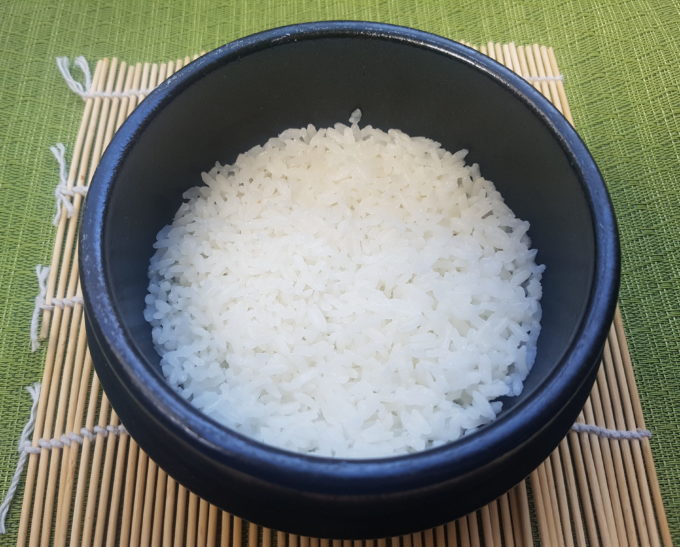

A true dolsot pot, traditionally made from agalmatolite but now commonly granite, is unmistakable.

A typical collection of varying ddukbaegi pot sizes in a small Asian market.
First, let’s distinguish the difference between a dolsot, a stone pot with a stone or wooden lid, and a ddukbaegi (sometimes written ttukbaegi), a ceramic pot that typically comes with no lid, although they are available. Besides the obvious appearance, the price tag is one of the first major differences. Here in Anchorage, and it appears about the same online, a basic dolsot is going to run you around $35. The ddukbaegi, however, come in a great variety of sizes with some of the smallest, (I’d call them child size,) running as cheap as 3 bucks. I got the second size up for our son and two slightly larger ones for my husband and I.
One of the greatest about these ddukbaegi, is that you can use them for any dish you might otherwise have cooked in a dutch oven. They are typically used right on the stove top, be-it either flame or electric, but you can also use them in the oven! For the stove top you simply need to start the heat off low for a couple minutes to let the pot warm up. This avoids cracking it. As for the oven, this is actually how restaurants keep the pots hot and ready for orders as they come in. They simply pull a hot ddukbaegi out of the oven and load it with the desired ingredients. You can, however just as well, bake a meal inside the ddukbaegi. Everyone gets their own customized meal. Your options are endless.

The secret to good nurugji is to get a good little bit of browning on the rice, but not to burn it, when the rice is being steamed.
Although cooking rice in a standard pot or rice steamer is easy enough, and I’m sure every one already has their standard method, I wanted to try my hand at the more traditional way of cooking it right in the ddukbaegi. The best part of this is followed when you have used all of the rice from the dish but are left with the crusted bits on the bottom. I’m sure that most of us would have normally just soaked this out and discarded it, but then you would be missing out on another wonderful Korean tradition; serving the nurungji (누릉지)!
To do this properly the hot pot filled with rice would have arrived at the table with the other delicious morsels you are eating. This could be a soup or stew, or maybe just a collection of banchan. The rice gets removed right away, either to a separate dish or distributed among the consumers, and either water or tea is added just to the line where the crusty rice stops. Because the pot is still very hot this will probably boil on contact, then, while everyone is enjoying their main dish, it will slowly loosen this crusted rice. Similar to the idea of enjoying an after dinner cup of coffee, this soup-beverage gets distributed among the attendees and everyone finishes the dining experience with a bit of socializing.
To season a stone dolsot pot:
(Ceramic ddukbaegi do not need to be seasoned)
- First rinse it well with clean water.
- Then fill it again about 3/4 full with the addition of a tablespoon of salt. Place it on the burner over low heat, then bring this up to medium after about 2 minutes, and allow to simmer/boil for 10 minutes.
- Using oven mitts or a towel, dump out the water and allow the bowl to cool to the touch.
- With either olive oil or sesame oil, which ever you prefer flavor-wise, coat the inside surface completely. The bowl is going to absorb much of this. Continue adding oil as needed, until the stone no longer absorbs it, then wipe off excess. Your pot is ready!
A note about purchasing a stone dolsot: Look for one that has the metal band around both the rim and the bottom. These help keep your pot from cracking. Be aware that small superficial cracks do happen, and these are fine, as long as they don’t allow the contents to seep out.
Cooking Rice in a Dolsot or Ddukbaegi
By: Semiserious Chefs
Servings Vary
Ingredients:
- Rice and Water, proportioned to the packaged instructions
I use Niko Niko Calrose Rice with a ratio of 1 part rice to 1.5 parts water.
Directions:
- Place your dolsot or ddukbaegi on the burner (either gas or electric) over low heat.
- Add the amount of rice and water you plan to cook, making sure to leave room for expansion. Add the lid, or cover the top with a small plate or bowl.
- After a couple of minutes bring the temperature up to medium. (This process assures you won’t crack your pot.)
- Even at medium the retained heat within the pot will be enough to bring a boil. When boiling has occurred reduce the heat to low and allow to simmer for 20 minutes, until all of the rice is soft and the water has been absorbed.
- Using oven mitts or a towel, bring the pot to the serving table and place it on a trivet.
- If you are planning to serve nurungji, (see above,) you will want to remove or serve all of the rice at the beginning of the meal and add enough water or tea to cover the crispy bits of rice on the bottom.
- To clean your pot simply rinse with warm water and use a wash rag to remove any bits of rice. No soap or scouring is needed.

Post a comment